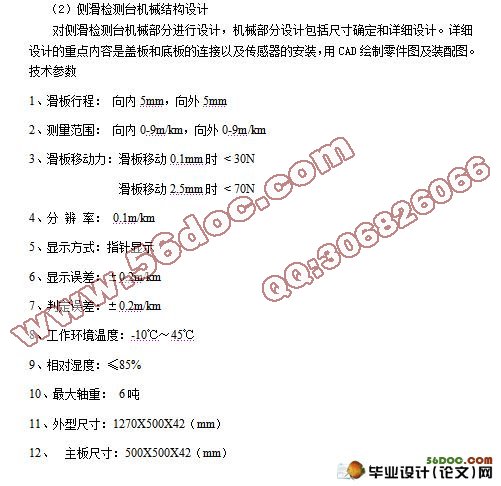汽车侧滑检测台设计
来源:wenku163.com 资料编号:WK1639281 资料等级:★★★★★ %E8%B5%84%E6%96%99%E7%BC%96%E5%8F%B7%EF%BC%9AWK1639281
资料介绍
汽车侧滑检测台设计(任务书,开题报告,毕业论文说明书20000字,CAD图纸7张)
摘 要
随着我国交通运输业的迅猛发展,汽车的增多,汽车的使用越来越普遍。汽车在高速行驶时,其稳定性受前轮定位参数影响较大,其中,以车轮外倾和前束两参数的影响为最大。当车轮前束值和车轮外倾角配合不当时,会引起车轮承受侧向力而产生侧向滑移现象,这将破坏车轮的附着条件,丧失定向行驶的能力,引发交通事故并导致轮胎的异常磨损。在汽车行驶时前轮侧滑量直接反映了前轮定位参数调整的准确与否,汽车侧滑检测台用来检查车轮侧滑量的大小与方向,从而确认车轮前束与车轮外倾角的配合是否恰当。汽车前轮通过侧滑台滑板时,由于滑板的侧向移动仅受滑板与支撑滚轮间的摩擦力和滑板的回位弹簧拉力的约束,同时轮胎与滑板间有足够的侧向位移。这样,在前束和外倾的综合作用下,若前轮的自由滚动方向偏离实际行驶方向,只要所产生的侧向力大于滑板与滚轮间摩擦力和弹簧弹性恢复力之和,前轮向前滚动的同时便会带动滑板侧滑。这设计包括侧滑板,钢板,直线位移传感器,钢槽,导轨,底座等等。
关键词:汽车;侧滑;位移传感器;前束;外倾;导轨
ABSTRACT
With rapidly developing of traffic and transport as well as rising of vehicles in our country, The number of double-front-axle steering automobile is also increasing When the car is driving at high speed, its stability is deeply effected by front wheel alignment parameters. Among them, the toe-in value and camber value have the largest effection. When the toe-in value cann’t match the camber angle, it will induce the wheel supporting side direction force, consequently come into being slid phenomenon. It will induce traffic accidents and cause tires’ abnormal wearing. During the automobile’s driving period, front-wheel slid value impact directly to the correct or not of front wheel alignment parameters adjustment. Car slid tester is used to check the amount and direction of wheels’ slid value. To ensure the correct matching between wheel toe-in and wheel camber angle. Auto front through the sideslip tester, because the board board by moving subject only to the skateboard wheel and support the friction between the return of spring tension and skateboard, while the constraints between tires and skateboarding has enough lateral displacement. So, before the comprehensive function outward exert bundles and, if the freedom front wheel rolling direction deviating from the practice driving direction, as long as the lateral force generated more than skateboard and roller of friction and spring between elastic restoring force, the sum of the front wheel rolling forward while will drive skateboarding lateral spreads. This designation introduces Side skateboard steel Linear displacement sensor Steel racks guide base and so on
Key words: Automobile; slid; displace;toein; outward exert ;guide
课题的主要研究内容及技术途径
(1)进行调研,收集与侧滑检测台有关的资料;综合分析国内外侧滑检测台设计方面的区别,找出不同之处,并为国内侧滑检测台设计提出相应的改进方法和进行优化设计;
(2)侧滑检测台机械结构设计
对侧滑检测台机械部分进行设计,机械部分设计包括尺寸确定和详细设计。详细设计的重点内容是盖板和底板的连接以及传感器的安装,用CAD绘制零件图及装配图。




目 录
第1章 绪论………………………………………………………………………………1
1.1课题的提出………………………………………………………………………2
1.2国内外相关技术的现状及发展方向……………………………………………2
1.3课题的主要研究内容及技术途径………………………………………………2
第2章 侧滑检测台总体方案的论证………………………………………………3
2.1 侧滑的基础知识…………………………………………………………………3
2.1.1 侧滑的产生原因……………………………………………………………4
2.1.2 正前束引起正侧滑,正外倾引起负侧滑……………………………………4
2.1.3 影响侧滑量的因素……………………………………………………………4
2.1.4 汽车前轮侧滑量对汽车使用性能的影响………………………………5
2.2 侧滑试验台的结构与工作原理…………………………………………………5
2.2.1 侧滑试验台设计方案的确定…………………………………………………5
2.2.2 单板式侧滑台的工作原理……………………………………………………6
2.3本章小结………………………………………………………………………8
第3章 侧滑检测台设计说明………………………………………………………10
3.1 侧滑检测台机械系统设计说明…………………………………………………10
3.1.1总体尺寸的确定………………………………………………………………10
3.1.2材料的选择……………………………………………………………………10
3.1.3侧滑板机械结构设计…………………………………………………………11
3.1.4侧滑检验台及各零件尺寸……………………………………………………12
3.2 侧滑检测台控制系统设计说明…………………………………………………12
3.2.1 硬件系统结构及工作原理……………………………………………………12
3.2.2传感器的选择及其信号处理电路设计………………………………………13
3.2.3位移传感器信号处理电路设计………………………………………………15
3.2.4 V/I转换电路设计………………………………………………………16
3.2.5 I/V转换电路设计……………………………………………………………17
3.2.6隔离放大环节设计……………………………………………………………18
3.2.7数据采集系统的设计…………………………………………………………19
3.3 本章小结………………………………………………………………………22
第4章 侧滑检测台的技术要求……………………………………………………25
4.1 侧滑检测台的使用方法…………………………………………………………25
4.1.1 检测前的准备…………………………………………………………………25
4.1.2检测步骤………………………………………………………………………25
4.1.3 检测时的注意事项……………………………………………………………25
4.2 侧滑台的维护……………………………………………………………………26
4.3侧滑检测台的检定和调整………………………………………………………26
4.3.1侧滑检测台的检定……………………………………………………………26
4.3.2 侧滑检测台的调整……………………………………………………………26
4.4本章小结…………………………………………………………………………29
结论………………………………………………………………………………………30
参考文献 ………………………………………………………………………………31
致谢………………………………………………………………………………………32
|









